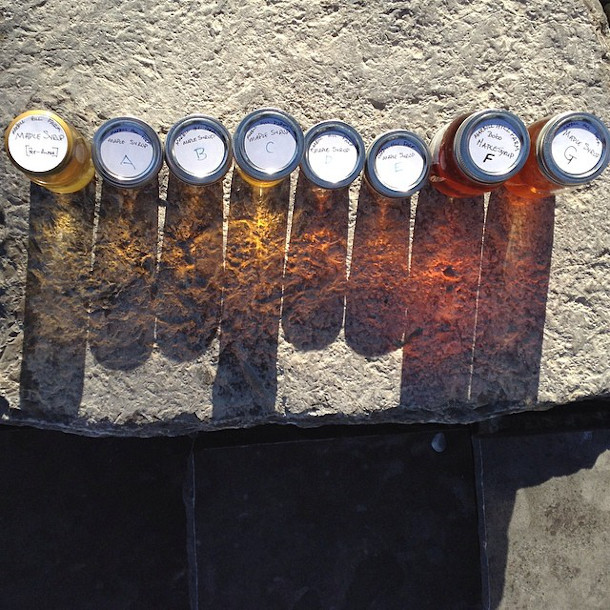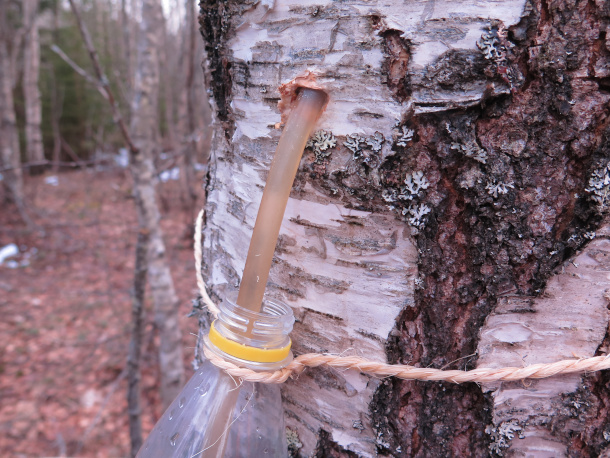Not Just Maple Syrup: Birch, Beech and Other Sappy Trees
Air Date: Week of March 26, 2021

Maple syrup is classified into different grades. A darker syrup indicates a stronger flavor. (Photo: LexnGer, Flickr, CC BY-NC 2.0)
It’s maple syrup season, but sugar maples aren’t the only sappy trees that can be tapped to make syrup. Host Bobby Bascomb visits syrup producer David Moore in New Hampshire to taste and learn about syrups made from birch, beech, walnut, and other trees.
Transcript
BASCOMB: These warm days and cold nights of spring mean it’s maple syrup season in much of the northeast. And like the crocuses that pop up through cold spring soil, sap buckets start to appear on maple trees across the region. But I recently visited a tree farmer in New Hampshire who produces syrup from other kinds of trees.
[WALKING SOUNDS]
BASCOMB: David Moore leads the way down a wide dirt path on his farm in Lee, New Hampshire. The path is lined on either side by stone walls built by farmers more than 200 years ago in the typical New England style. Those farmers were likely tapping maple trees this time of year. A skill no doubt learned from Native Americans in the region who have a long tradition with maple syrup. But David Moore is turning centuries of syrup making on its head.
MOORE: So, I have five beech trees tapped here. American beech. You need a vacuum pump to extract sap. Maple and birch, the sap will come out of the tree without a vacuum but other species you need a vacuum.
BASCOMB: Light blue plastic tubes jut out from each of the 5 beech trees in this stand. Another tube runs through a vacuum pump covered by an inverted plastic bin and into a plastic bucket.
[OPENING BUCKET SOUNDS]
BASCOMB: David takes the top of the bucket. Inside, a couple inches of frozen beech sap.
MOORE: Maybe one gallon or so. So this is about what I've been getting from these trees.
BASCOMB: David tells me he had more luck tapping a different set of beech trees last year and got a lot more sap. Still, he’ll need something like 200 gallons of beech sap to get one gallon of syrup. The sugar content for good old maple syrup is far more concentrated. So it takes just 40 gallons of maple sap to make a gallon of syrup.
MOORE: So nothing will replace maples. But it'll certainly add some value to your operation if you can do it.
BASCOMB: And that is David’s goal here. For his PhD work at the University of New Hampshire, he wants to figure out the best trees, other than maple, to tap and make syrup. It could be useful information for maple syrup producers in the region. They could use their existing equipment to tap other kinds of trees on their lan and make more money.
MOORE: Just getting a little more value out of your woods and especially with beech. Beech around here is thought to be just a really weedy kind of a nuisance species. And so if there's if there's a good use for it, then… yeah, just good for the producer.
BASCOMB: More than 20 different species of trees can be used to make syrup. Here on the farm, David is experimenting with basswood, poplar, hickory, sycamore and the beech he’s been showing me. Right now most alternative syrups are a lot more expensive than maple, largely because that sap to syrup ratio is so much higher. Still, David says there is a niche market for his syrups.
MOORE: I would sell to farmers markets in the beginning and specialty food stores. Several different restaurants, and also a lot of mail orders.

Harvesting sap from a birch tree. Maple trees are not the only sources to make syrup. (Photo: Ole Husby, Flickr, CC BY-SA 2.0)
BASCOMB: I’ve never had anything other than maple syrup so to see what I’ve been missing out on he invites me try a couple.
[CLINKING OF SILVERWARE, PLATES]
MOORE: Alright, so I have some birch syrup that I made. And some beech syrup from upstate New York from my friend Mike. So, should we try the birch first?
BASCOMB: Yeah, sounds great.
[BOTTLE OPENING SOUND]
MOORE: there you go.
BASCOMB: Thank you. It looks really really dark, much darker and thicker than maple syrup usually is. Yeah, let me try it. Let me take off the mask here. Wow. It's different. Yeah, it's sweet. It's definitely sweet, but also not at the same time somehow. It's got like a familiar flavor that I can't quite put my finger on.
MOORE: Miso?
BASCOMB: Miso! I don't know about that. Maybe molasses.
MOORE: It's nice as a glaze on red meat and salmon. Yeah. And it's also nice if you mix it with olive oil and balsamic vinegar to make a salad dressing. Should we try some beech?
BASCOMB: Yeah, sounds great.
[FAINT SOUND OF TASTING]
BASCOMB: That is a lot more like maple syrup.
MOORE: Yeah.
BASCOMB: Yeah, it's really good. I wouldn't I wouldn't think this isn't maple syrup. If you've put this on a pancake and gave it to me.
MOORE: I think if we had walnut syrup, here, you would have the same reaction tastes a lot like maple with a little more maybe nuttiness to it. But yeah, birch is pretty different Sycamore I would say is pretty different. So, yeah, cool. I'm glad you like them.
BASCOMB: Yeah, I really do. And I have to say, I really learned something new today. I had no idea before, you know, coming out here to meet you that you can make syrup out of anything but maple. So you really opened my eyes today.
MOORE: Yeah, thanks, Bobby. Thanks for coming out. This was a lot of fun.
BASCOMB: Yeah, it was Thank you.
Even before David Moore finishes his PhD at the University of New Hampshire he may find his research is in high demand. With the changing climate maple syrup production can be a lot more variable. Making alternatives more attractive. I hear sycamore actually tastes like butterscotch or honey but there wasn’t any ready yet for me to try on David’s farm. Maybe next time.
Links
Living on Earth wants to hear from you!
Living on Earth
62 Calef Highway, Suite 212
Lee, NH 03861
Telephone: 617-287-4121
E-mail: comments@loe.org
Newsletter [Click here]
Donate to Living on Earth!
Living on Earth is an independent media program and relies entirely on contributions from listeners and institutions supporting public service. Please donate now to preserve an independent environmental voice.
NewsletterLiving on Earth offers a weekly delivery of the show's rundown to your mailbox. Sign up for our newsletter today!
 Sailors For The Sea: Be the change you want to sea.
Sailors For The Sea: Be the change you want to sea.
 The Grantham Foundation for the Protection of the Environment: Committed to protecting and improving the health of the global environment.
The Grantham Foundation for the Protection of the Environment: Committed to protecting and improving the health of the global environment.
 Contribute to Living on Earth and receive, as our gift to you, an archival print of one of Mark Seth Lender's extraordinary wildlife photographs. Follow the link to see Mark's current collection of photographs.
Contribute to Living on Earth and receive, as our gift to you, an archival print of one of Mark Seth Lender's extraordinary wildlife photographs. Follow the link to see Mark's current collection of photographs.
 Buy a signed copy of Mark Seth Lender's book Smeagull the Seagull & support Living on Earth
Buy a signed copy of Mark Seth Lender's book Smeagull the Seagull & support Living on Earth

